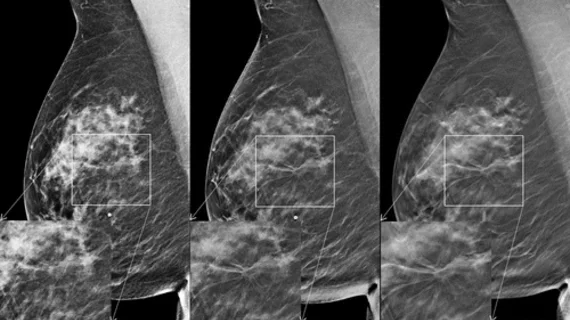Digital breast tomosynthesis (DBT) can help radiologists detect more architectural distortion (AD) lesions than 2D mammography alone, according to a new study published in Radiology. AD lesions detected only by DBT have a lower malignancy rate than AD lesions detected by 2D mammography, but the rate is still high enough to warrant a biopsy.
Lead author Taghreed I. Alshafeiy, MD, University of Virginia Health System in Charlottesville, Virginia, and colleagues studied data from patients with AD assigned BI-RADS categories 4 or 5 from 2009 to 2016 at a single institution. Overall, more than 67 percent of AD lesions were visible with 2D and more than 32 percent were detected only with DBT. The malignancy rate, based on final pathology, was “significantly higher” for AD lesions detected with 2D mammography (43.4 percent) compared to those detected only by DBT (10.2 percent).
While 10.2 percent is a considerably lower malignancy rate, Alshafeiy et al. noted, the rate “is still too high to warrant follow up rather than biopsy.”
“Women with suspicious AD detected only at DBT should undergo biopsy even when a correlate is not identified at ultrasonography because of the greater than 2 percent risk of malignancy,” they wrote.
And why is the malignancy rate lower for AD lesions detected only by DBT?
“This could be attributed to the difference in conspicuity of lesions between the two modalities,” the authors wrote. “A mass with spiculated margins can be concealed by dense breast at 2D and classified as an area of AD, while a central mass with spiculated margins may be identified at DBT. So the [positive predictive value] for malignancy of AD detected by 2D mammography may be higher than that of AD detected by only at DBT because the mass is obscured at 2D.”
The authors noted that their study did have limitations. For example, the data was only from a single institution and only included “a relatively small number of lesions.”
Read the study in the RSNA journal.
More Coverage of Architectural Distortion:
When does worrisome architectural distortion signal malignancy on mammography?
New research can help radiologists manage architectural distortion identified via DBT exams
3D mammography detects more architectural distortions than 2D
Tomosynthesis trumps mammo alone for spotting architectural distortion

